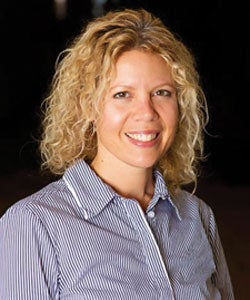Q&A with Brenda Holland, D.C., on the importance of women taking a seat on all national chiropractic associations
 Brenda Holland, D.C. (Main, ’03), is the vice president of the Wisconsin Chiropractic Association (WCA) and president of ChiroCongress. She spoke with Palmer Proud about her roles and the importance of women leaders in the profession.
Brenda Holland, D.C. (Main, ’03), is the vice president of the Wisconsin Chiropractic Association (WCA) and president of ChiroCongress. She spoke with Palmer Proud about her roles and the importance of women leaders in the profession.
Tell us about your chiropractic journey.
I grew up on a farm and always thought the only thing I would ever do would be “farm stuff.” Then my dad passed away when I was 13, and it changed the trajectory of my life. My mom always supported and encouraged me to think big and not sit on the sidelines, so, I took on leadership roles in high school and during my undergraduate education.
When I got to Palmer, I noticed a stark difference in the ratio of males to females. We were one of the biggest classes with the most females, and there still weren’t very many of us. I craved the camaraderie of women going through the same things I was, so I pledged Sigma Phi Chi. Having the support of a group of strong women allowed me to pursue leadership positions at Palmer, which prepared me for life after Palmer.
How did you become involved in chiropractic associations?
After graduation, I didn’t have as strong of a support network as I had at Palmer. Brian Gerondale, D.C. (Main, ’82), head doctor at Chiropractic Company, said, “Why don’t you participate in our state association? You’re fortunate enough to do what you love to do. You have to give back to the people that come after you.” That really resonated with me.
I ran for Marquee Metro District Director and was elected. That started my journey in the WCA. I filled multiple roles and chair positions and was eventually nominated vice president. From there, the WCA decided to become more active in ChiroCongress, and I was nominated by our board to run for the District 2 position that represents the eight Midwestern states.
Through hard work, dependability and remaining approachable, I was able to rise to the leadership positions I currently hold.
Why is it important for women in the profession to get involved in associations?
If you don’t have a seat at the table, you’re probably on the menu. If you want to make changes and strengthen the profession, you need to roll up your sleeves and get involved.
Female chiropractors are entering the workforce, and they’re looking for opportunities to have a real work-life balance — that means having a family and still having a fulfilling practice. State associations fight for you every day to get you better payer reimbursement and provide resources to help make your office run smoothly.
State associations also provide you with an opportunity to connect with your peers and renew the connections with other women who are going through the same life experiences you are. Who doesn’t need a support network of like-minded people who want to see everyone well adjusted?
What does it mean to you to see the growth of women leaders in chiropractic?
This is the first time in the history of the profession that women are at the helm of all the national associations — the ACA, ICA, ABCA, FCLB and ChiroCongress. I’m ecstatic. The women who came before us blazed the trail, and now we’re laying the foundation and the next group of women leaders will be driving forward into the next 125 years! As we see the enrollment of females in chiropractic colleges surpass 50 percent in the U.S., this group of females represents the next chapter in chiropractic.
What is one piece of advice you’d offer young women entering the profession?
Join your state association. It’s about creating your network, that tribe of people who are going through the same experiences you are. But I have a second one, too: find a mentor (and your state association can help with that!). Multiple resources are available, from setting up your practice to working with insurance, from finding a mentor to posting job openings.
What do you hope for the next 125 years of women in the profession?
In the next 125 years, women will represent the majority of providers nationally. That will translate into more women being represented on the boards of our state and our national associations. It’s our diversity that will help our profession grow and create unity without uniformity. I hope the women who read this 125 years from now will be part of a profession that’s diverse and inclusive and represents the patients we serve. This is possible. The next group of women is more resilient than any of us because they are Palmer and by nature are driven forward.
 Brenda Holland, D.C. (Main, ’03), is the vice president of the Wisconsin Chiropractic Association (WCA) and president of ChiroCongress. She spoke with Palmer Proud about her roles and the importance of women leaders in the profession.
Brenda Holland, D.C. (Main, ’03), is the vice president of the Wisconsin Chiropractic Association (WCA) and president of ChiroCongress. She spoke with Palmer Proud about her roles and the importance of women leaders in the profession.